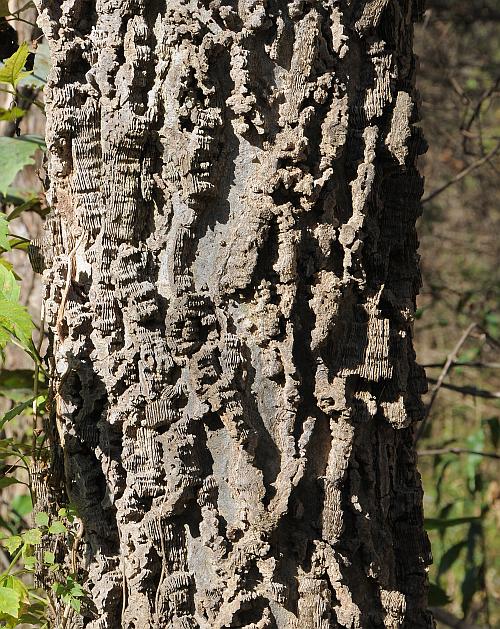Celtis occidentalis L.
Northern Hackberry

Native
CC = 3
CW = 3
MOC = 81
© SRTurner
Celtis occidentalis L.Northern Hackberry | |
 |
Native CC = 3 CW = 3 MOC = 81 |
© SRTurner |
|
Family - Ulmaceae Habit - Medium to large trees 10-35 m tall, typically with one strong, vertical trunk (occasionally with 2 or 3 parallel, strongly ascending trunks). Stems - Bark of trunk and large branches with prominent corky ridges and/or warts. Twigs usually glabrous, the winter buds axillary, 1.5-5.0 mm, ovoid or flattened, bluntly pointed at the tip, with several overlapping scales, orange-brown or purple, glabrous or minutely hairy.
Leaves - Spirally alternate, simple, petiolate. Blades 7-12 cm long, 4.0-7.7 cm wide, obliquely triangular-ovate, very obliquely truncate or sometimes slightly asymmetrically rounded at the base; gradually tapered to a slender, sharply pointed tip, the margins relatively evenly toothed with 12-27 teeth on the shorter side and 23-40 teeth on the longer side; the upper surface smooth or slightly roughened, the secondary veins 5-8 on each side, the basal secondary veins extending to 1/3-2/5 of blade length (occasionally to 1/2 the blade length on one side), both surfaces bright green or the undersurface somewhat paler, the undersurface with sparse hairs along the main veins and often also with dense tufts of hairs in the vein axils. Leaves of different growth stages or from different parts of the plant may show considerable variation from these descriptions.
Inflorescences - Staminate flowers in small, dense clusters at the base of current-year's growth. Perfect flowers solitary in the axils of the lowest expanding leaves of the current season. Flower stalks 12-24 mm long, 1.2-2.2 times as long as the subtending petiole, glabrous.
Flowers - Calyces 2-3 mm long, shallowly to deeply 4-lobed, but the lobes usually shed early, green to greenish yellow, turning brown after flowering. Stamens with the anthers yellow to greenish yellow and always dehiscent, the pollen copious and well-formed.
Fruits - Spherical drupes, 8-10 mm long, dark brownish purple when fully mature, the outer layer thin, glabrous, smooth, sometimes somewhat glaucous; the middle layer thin, fleshy, sweet-tasting, the seeds covered by a large, stony endocarp.
Flowering - March - April. Habitat - Bottomland and mesic forests, streambanks, pond margins, bases of bluffs, fields, cemeteries, roadsides. Origin - Native to the U.S. Lookalikes - C. laevigata, Ulmus spp. Other info. - This tree is usually recognized by its bark, which bears distinctive corky warts and ridges. This character is quite variable but usually present to at least some degree on trunks which are at least a few inches in diameter. The leaves are also distinctive, with conspicuously asymmetric bases. The leaves are toothed all along both sides, with at least 20 teeth on the longer side. The number of teeth and relatively large size of the leaves differentiate this species from its sibling C. laevigata (sugarberry). However, Yatskievych notes in Flora of Missouri that Celtis is a difficult genus with considerable variability in most characters. This variability is inherent and not due to crossing of species. Photographs taken at Indian Camp Creek Park, St. Charles County, MO, 10-24-2016, and along the Katy Trail near Dutzow, Warren County, MO, 4-3-2020, 8-26-2021, and 7-29-2022 (SRTurner). |